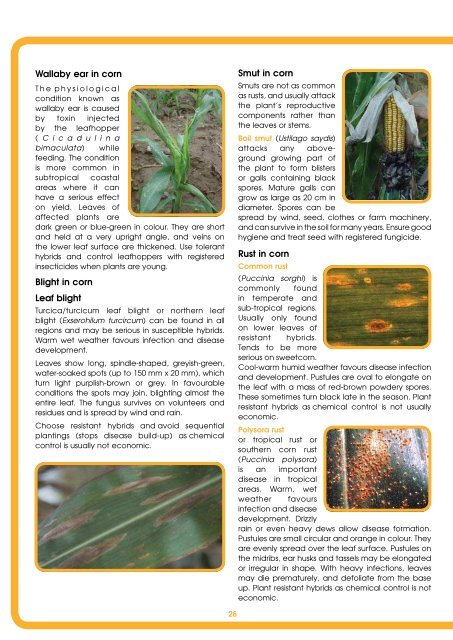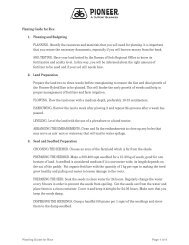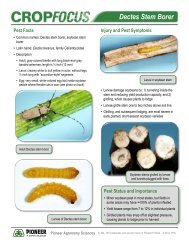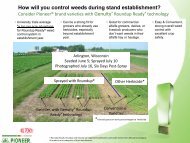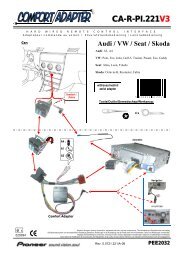Corn Work Shop Book - Pioneer
Corn Work Shop Book - Pioneer
Corn Work Shop Book - Pioneer
Create successful ePaper yourself
Turn your PDF publications into a flip-book with our unique Google optimized e-Paper software.
Wallaby ear in corn<br />
T h e p h y s i o l o g i c a l<br />
condition known as<br />
wallaby ear is caused<br />
by toxin injected<br />
by the leafhopper<br />
( C i c a d u l i n a<br />
bimaculata) while<br />
feeding. The condition<br />
is more common in<br />
subtropical coastal<br />
areas where it can<br />
have a serious effect<br />
on yield. Leaves of<br />
affected plants are<br />
dark green or blue-green in colour. They are short<br />
and held at a very upright angle, and veins on<br />
the lower leaf surface are thickened. Use tolerant<br />
hybrids and control leafhoppers with registered<br />
insecticides when plants are young.<br />
Blight in corn<br />
Leaf blight<br />
Turcica/turcicum leaf blight or northern leaf<br />
blight (Exserohilum turcircum) can be found in all<br />
regions and may be serious in susceptible hybrids.<br />
Warm wet weather favours infection and disease<br />
development.<br />
Leaves show long, spindle-shaped, greyish-green,<br />
water-soaked spots (up to 150 mm x 20 mm), which<br />
turn light purplish-brown or grey. In favourable<br />
conditions the spots may join, blighting almost the<br />
entire leaf. The fungus survives on volunteers and<br />
residues and is spread by wind and rain.<br />
Choose resistant hybrids and avoid sequential<br />
plantings (stops disease build-up) as chemical<br />
control is usually not economic.<br />
Smut in corn<br />
Smuts are not as common<br />
as rusts, and usually attack<br />
the plant’s reproductive<br />
components rather than<br />
the leaves or stems.<br />
Boil smut (Ustilago saydis)<br />
attacks any aboveground<br />
growing part of<br />
the plant to form blisters<br />
or galls containing black<br />
spores. Mature galls can<br />
grow as large as 20 cm in<br />
diameter. Spores can be<br />
spread by wind, seed, clothes or farm machinery,<br />
and can survive in the soil for many years. Ensure good<br />
hygiene and treat seed with registered fungicide.<br />
Rust in corn<br />
Common rust<br />
(Puccinia sorghi) is<br />
commonly found<br />
in temperate and<br />
sub-tropical regions.<br />
Usually only found<br />
on lower leaves of<br />
resistant hybrids.<br />
Tends to be more<br />
serious on sweetcorn.<br />
Cool-warm humid weather favours disease infection<br />
and development. Pustules are oval to elongate on<br />
the leaf with a mass of red-brown powdery spores.<br />
These sometimes turn black late in the season. Plant<br />
resistant hybrids as chemical control is not usually<br />
economic.<br />
Polysora rust<br />
or tropical rust or<br />
southern corn rust<br />
(Puccinia polysora)<br />
is an important<br />
disease in tropical<br />
areas. Warm, wet<br />
weather favours<br />
infection and disease<br />
development. Drizzly<br />
rain or even heavy dews allow disease formation.<br />
Pustules are small circular and orange in colour. They<br />
are evenly spread over the leaf surface. Pustules on<br />
the midribs, ear husks and tassels may be elongated<br />
or irregular in shape. With heavy infections, leaves<br />
may die prematurely, and defoliate from the base<br />
up. Plant resistant hybrids as chemical control is not<br />
economic.<br />
8e. Multiple cobbing<br />
All corn plants have the ability to produce more<br />
than one cob. Some hybrids produce multiple cobs<br />
more than others. Hybrids that do not produce<br />
many double cobs are more likely to have a greater<br />
ability to flex the primary ear size. In a high yielding<br />
environment, yields will be maximised if farmers aim<br />
to produce one good ear per plant.<br />
Therefore, the decision should not be to select a<br />
hybrid on its ability to double cob, but rather on its<br />
overall yield performance whether this is done by a<br />
single cob or more.<br />
8f. Husk cover<br />
Husk cover is important in environments where the<br />
maturing grain can be damaged by weather or<br />
ear rots.<br />
In some hybrids the ear is borne on a long shank<br />
and, as the ear matures, it tends to hang down and<br />
thus be protected. In hybrids with a short shank, the<br />
ear is held upright and it is important to have good<br />
husk cover in order to protect the ear.<br />
8g. Tillering<br />
Some hybrids can produce 1-2 tillers and this is<br />
generally considered an undesirable trait in corn<br />
hybrids. This does not necessarily mean that hybrids<br />
that produce tillers are any less efficient, or will be<br />
any lower yielding than hybrids that don't produce<br />
tillers. As well as genetic differences between<br />
hybrids, the following factors appear to increase<br />
the incidence of tillering:<br />
• Cooler temperatures early in the growing season<br />
• Lower plant populations<br />
• High levels of soil fertility relative to the plant<br />
population.<br />
28 29<br />
In some situations, hermaphrodite ears may form at<br />
the top of the tiller. In most cases early formed tillers<br />
reflect favourable growing conditions and tend to<br />
die off (with nutrients transferred to the main stem)<br />
as the season and crop progresses.<br />
Choosing the hybrid<br />
The task of choosing the best hybrid (or hybrids)<br />
to plant should be simplified if each of the points<br />
discussed above is considered. Unfortunately there<br />
never will be a hybrid that will give full protection to<br />
every environmental, disease and insect problem<br />
that maybe encountered during the growing season,<br />
as well as giving the top yield year in year out.<br />
Therefore it is up to the farmer to obtain as much<br />
relevant and unbiased information as possible, list<br />
his priorities, and decide the best hybrids for his<br />
property.<br />
Sources of information include:<br />
1) The research company that developed the hybrid<br />
- ask to see <strong>Pioneer</strong> Product Advancement Trial<br />
Data and strip test data from the local area: this is<br />
particularly important for new hybrids as they are<br />
released onto the market.<br />
2) Local farmer experience.<br />
3) Local seed distributors, many of whom conduct<br />
their own hybrid testing programs.<br />
It is a very good idea for farmers to conduct<br />
their own strip tests of new hybrids, and obtain<br />
their own information before commencing full-scale<br />
commercial production. <strong>Pioneer</strong> is very keen to assist<br />
farmers with strip-tests, from planting through to yield<br />
testing.


